Health Assessment Report: Adolescent Contemporary Issues and Resources
VerifiedAdded on 2022/09/27
|5
|1114
|40
Report
AI Summary
This report addresses the contemporary issue of internet and gaming addiction among adolescents, exploring its impact on behavior and well-being. It identifies external stressors like family and academic pressures. The assessment strategies include a family-centered approach and encouragement, with specific questions to gauge the extent of the problem while maintaining ethical boundaries regarding parental communication. The report discusses support options, including therapy (self-help groups, family, cognitive behavioral, and group therapy), and emphasizes the role of parents in monitoring their children's well-being and encouraging pro-social activities. The underlying physiological impact of stress, specifically the role of cortisol and adrenaline, is also discussed, along with relaxation techniques to mitigate their effects. The report highlights the importance of addressing the issue through therapy and emphasizes the treatable nature of internet addiction.
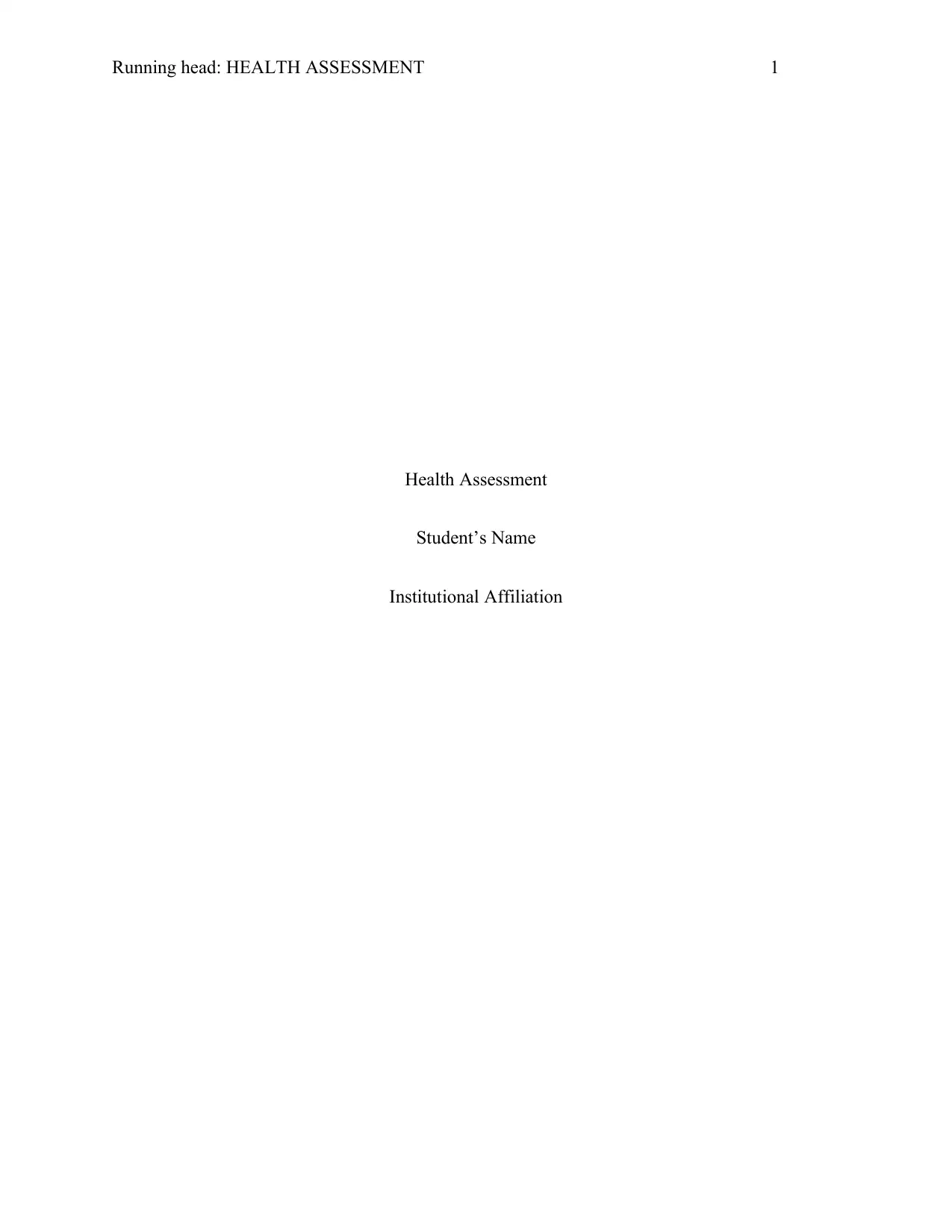
Running head: HEALTH ASSESSMENT 1
Health Assessment
Student’s Name
Institutional Affiliation
Health Assessment
Student’s Name
Institutional Affiliation
Paraphrase This Document
Need a fresh take? Get an instant paraphrase of this document with our AI Paraphraser
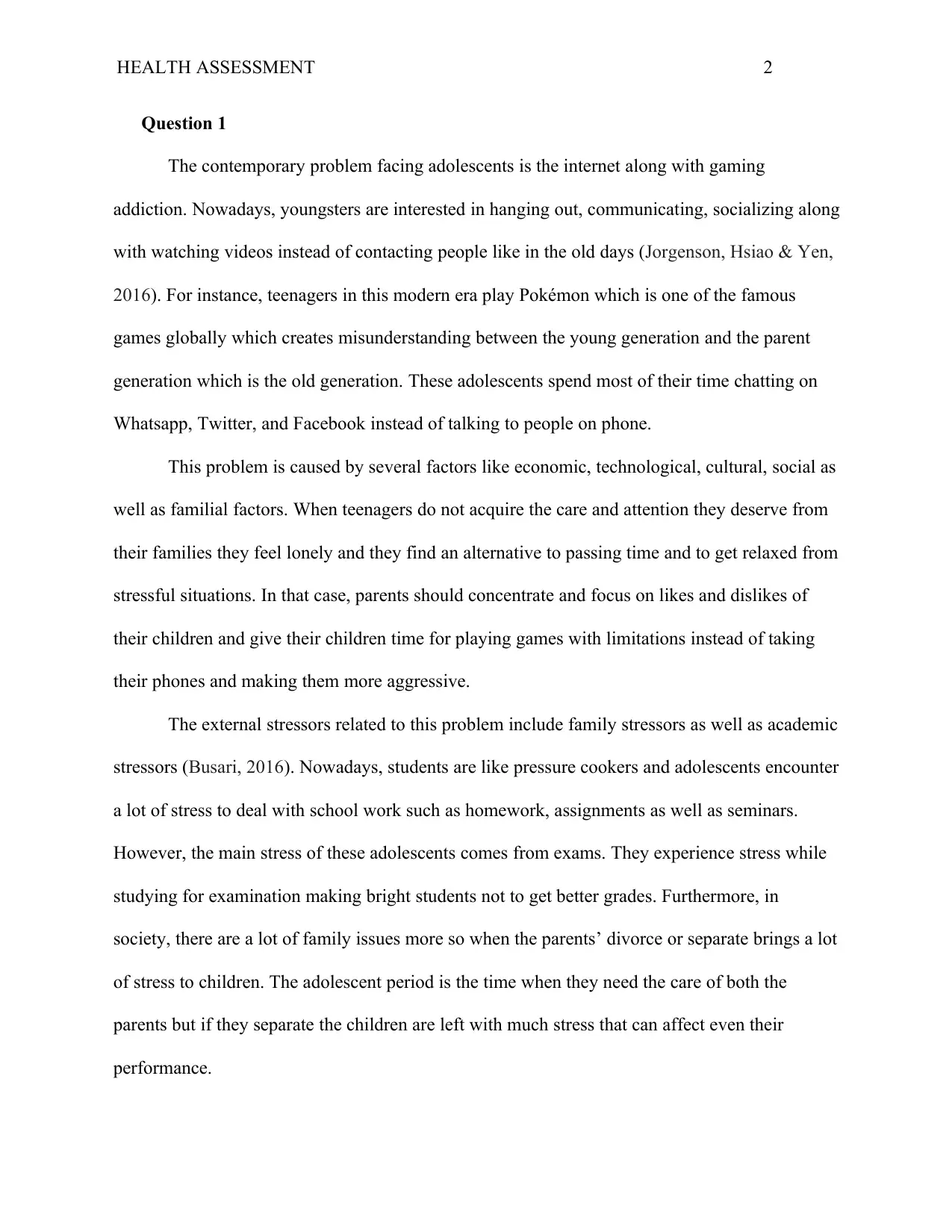
HEALTH ASSESSMENT 2
Question 1
The contemporary problem facing adolescents is the internet along with gaming
addiction. Nowadays, youngsters are interested in hanging out, communicating, socializing along
with watching videos instead of contacting people like in the old days (Jorgenson, Hsiao & Yen,
2016). For instance, teenagers in this modern era play Pokémon which is one of the famous
games globally which creates misunderstanding between the young generation and the parent
generation which is the old generation. These adolescents spend most of their time chatting on
Whatsapp, Twitter, and Facebook instead of talking to people on phone.
This problem is caused by several factors like economic, technological, cultural, social as
well as familial factors. When teenagers do not acquire the care and attention they deserve from
their families they feel lonely and they find an alternative to passing time and to get relaxed from
stressful situations. In that case, parents should concentrate and focus on likes and dislikes of
their children and give their children time for playing games with limitations instead of taking
their phones and making them more aggressive.
The external stressors related to this problem include family stressors as well as academic
stressors (Busari, 2016). Nowadays, students are like pressure cookers and adolescents encounter
a lot of stress to deal with school work such as homework, assignments as well as seminars.
However, the main stress of these adolescents comes from exams. They experience stress while
studying for examination making bright students not to get better grades. Furthermore, in
society, there are a lot of family issues more so when the parents’ divorce or separate brings a lot
of stress to children. The adolescent period is the time when they need the care of both the
parents but if they separate the children are left with much stress that can affect even their
performance.
Question 1
The contemporary problem facing adolescents is the internet along with gaming
addiction. Nowadays, youngsters are interested in hanging out, communicating, socializing along
with watching videos instead of contacting people like in the old days (Jorgenson, Hsiao & Yen,
2016). For instance, teenagers in this modern era play Pokémon which is one of the famous
games globally which creates misunderstanding between the young generation and the parent
generation which is the old generation. These adolescents spend most of their time chatting on
Whatsapp, Twitter, and Facebook instead of talking to people on phone.
This problem is caused by several factors like economic, technological, cultural, social as
well as familial factors. When teenagers do not acquire the care and attention they deserve from
their families they feel lonely and they find an alternative to passing time and to get relaxed from
stressful situations. In that case, parents should concentrate and focus on likes and dislikes of
their children and give their children time for playing games with limitations instead of taking
their phones and making them more aggressive.
The external stressors related to this problem include family stressors as well as academic
stressors (Busari, 2016). Nowadays, students are like pressure cookers and adolescents encounter
a lot of stress to deal with school work such as homework, assignments as well as seminars.
However, the main stress of these adolescents comes from exams. They experience stress while
studying for examination making bright students not to get better grades. Furthermore, in
society, there are a lot of family issues more so when the parents’ divorce or separate brings a lot
of stress to children. The adolescent period is the time when they need the care of both the
parents but if they separate the children are left with much stress that can affect even their
performance.
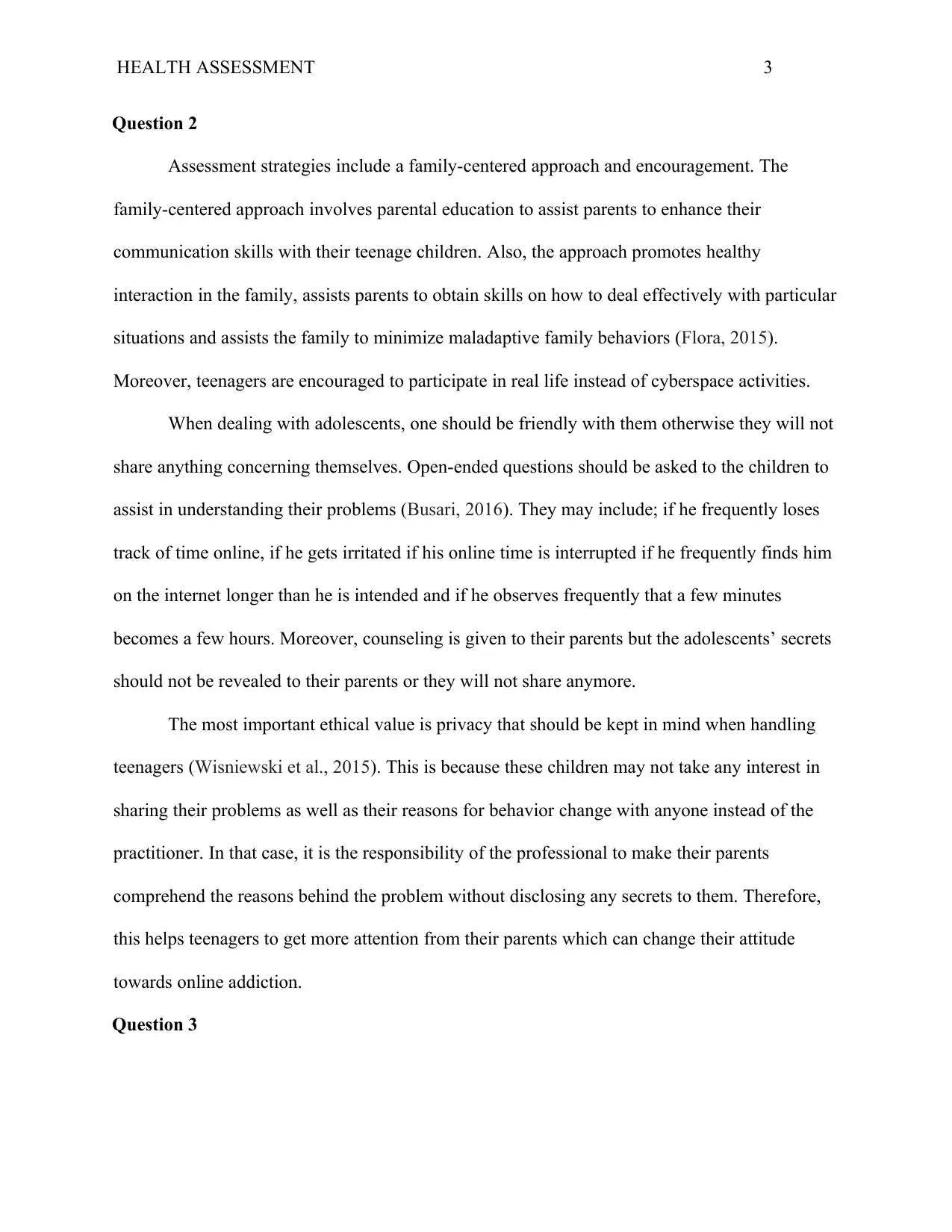
HEALTH ASSESSMENT 3
Question 2
Assessment strategies include a family-centered approach and encouragement. The
family-centered approach involves parental education to assist parents to enhance their
communication skills with their teenage children. Also, the approach promotes healthy
interaction in the family, assists parents to obtain skills on how to deal effectively with particular
situations and assists the family to minimize maladaptive family behaviors (Flora, 2015).
Moreover, teenagers are encouraged to participate in real life instead of cyberspace activities.
When dealing with adolescents, one should be friendly with them otherwise they will not
share anything concerning themselves. Open-ended questions should be asked to the children to
assist in understanding their problems (Busari, 2016). They may include; if he frequently loses
track of time online, if he gets irritated if his online time is interrupted if he frequently finds him
on the internet longer than he is intended and if he observes frequently that a few minutes
becomes a few hours. Moreover, counseling is given to their parents but the adolescents’ secrets
should not be revealed to their parents or they will not share anymore.
The most important ethical value is privacy that should be kept in mind when handling
teenagers (Wisniewski et al., 2015). This is because these children may not take any interest in
sharing their problems as well as their reasons for behavior change with anyone instead of the
practitioner. In that case, it is the responsibility of the professional to make their parents
comprehend the reasons behind the problem without disclosing any secrets to them. Therefore,
this helps teenagers to get more attention from their parents which can change their attitude
towards online addiction.
Question 3
Question 2
Assessment strategies include a family-centered approach and encouragement. The
family-centered approach involves parental education to assist parents to enhance their
communication skills with their teenage children. Also, the approach promotes healthy
interaction in the family, assists parents to obtain skills on how to deal effectively with particular
situations and assists the family to minimize maladaptive family behaviors (Flora, 2015).
Moreover, teenagers are encouraged to participate in real life instead of cyberspace activities.
When dealing with adolescents, one should be friendly with them otherwise they will not
share anything concerning themselves. Open-ended questions should be asked to the children to
assist in understanding their problems (Busari, 2016). They may include; if he frequently loses
track of time online, if he gets irritated if his online time is interrupted if he frequently finds him
on the internet longer than he is intended and if he observes frequently that a few minutes
becomes a few hours. Moreover, counseling is given to their parents but the adolescents’ secrets
should not be revealed to their parents or they will not share anymore.
The most important ethical value is privacy that should be kept in mind when handling
teenagers (Wisniewski et al., 2015). This is because these children may not take any interest in
sharing their problems as well as their reasons for behavior change with anyone instead of the
practitioner. In that case, it is the responsibility of the professional to make their parents
comprehend the reasons behind the problem without disclosing any secrets to them. Therefore,
this helps teenagers to get more attention from their parents which can change their attitude
towards online addiction.
Question 3
⊘ This is a preview!⊘
Do you want full access?
Subscribe today to unlock all pages.

Trusted by 1+ million students worldwide
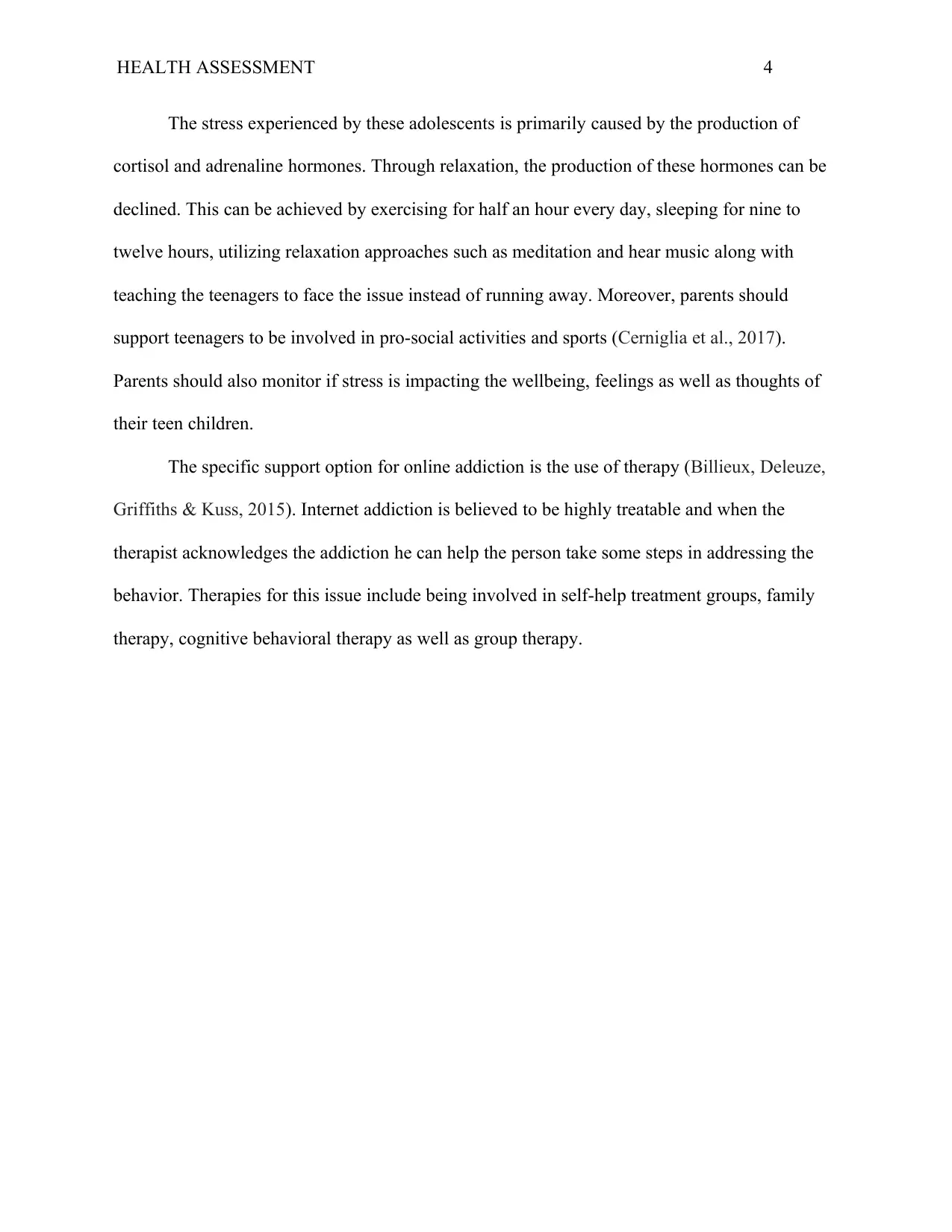
HEALTH ASSESSMENT 4
The stress experienced by these adolescents is primarily caused by the production of
cortisol and adrenaline hormones. Through relaxation, the production of these hormones can be
declined. This can be achieved by exercising for half an hour every day, sleeping for nine to
twelve hours, utilizing relaxation approaches such as meditation and hear music along with
teaching the teenagers to face the issue instead of running away. Moreover, parents should
support teenagers to be involved in pro-social activities and sports (Cerniglia et al., 2017).
Parents should also monitor if stress is impacting the wellbeing, feelings as well as thoughts of
their teen children.
The specific support option for online addiction is the use of therapy (Billieux, Deleuze,
Griffiths & Kuss, 2015). Internet addiction is believed to be highly treatable and when the
therapist acknowledges the addiction he can help the person take some steps in addressing the
behavior. Therapies for this issue include being involved in self-help treatment groups, family
therapy, cognitive behavioral therapy as well as group therapy.
The stress experienced by these adolescents is primarily caused by the production of
cortisol and adrenaline hormones. Through relaxation, the production of these hormones can be
declined. This can be achieved by exercising for half an hour every day, sleeping for nine to
twelve hours, utilizing relaxation approaches such as meditation and hear music along with
teaching the teenagers to face the issue instead of running away. Moreover, parents should
support teenagers to be involved in pro-social activities and sports (Cerniglia et al., 2017).
Parents should also monitor if stress is impacting the wellbeing, feelings as well as thoughts of
their teen children.
The specific support option for online addiction is the use of therapy (Billieux, Deleuze,
Griffiths & Kuss, 2015). Internet addiction is believed to be highly treatable and when the
therapist acknowledges the addiction he can help the person take some steps in addressing the
behavior. Therapies for this issue include being involved in self-help treatment groups, family
therapy, cognitive behavioral therapy as well as group therapy.
Paraphrase This Document
Need a fresh take? Get an instant paraphrase of this document with our AI Paraphraser
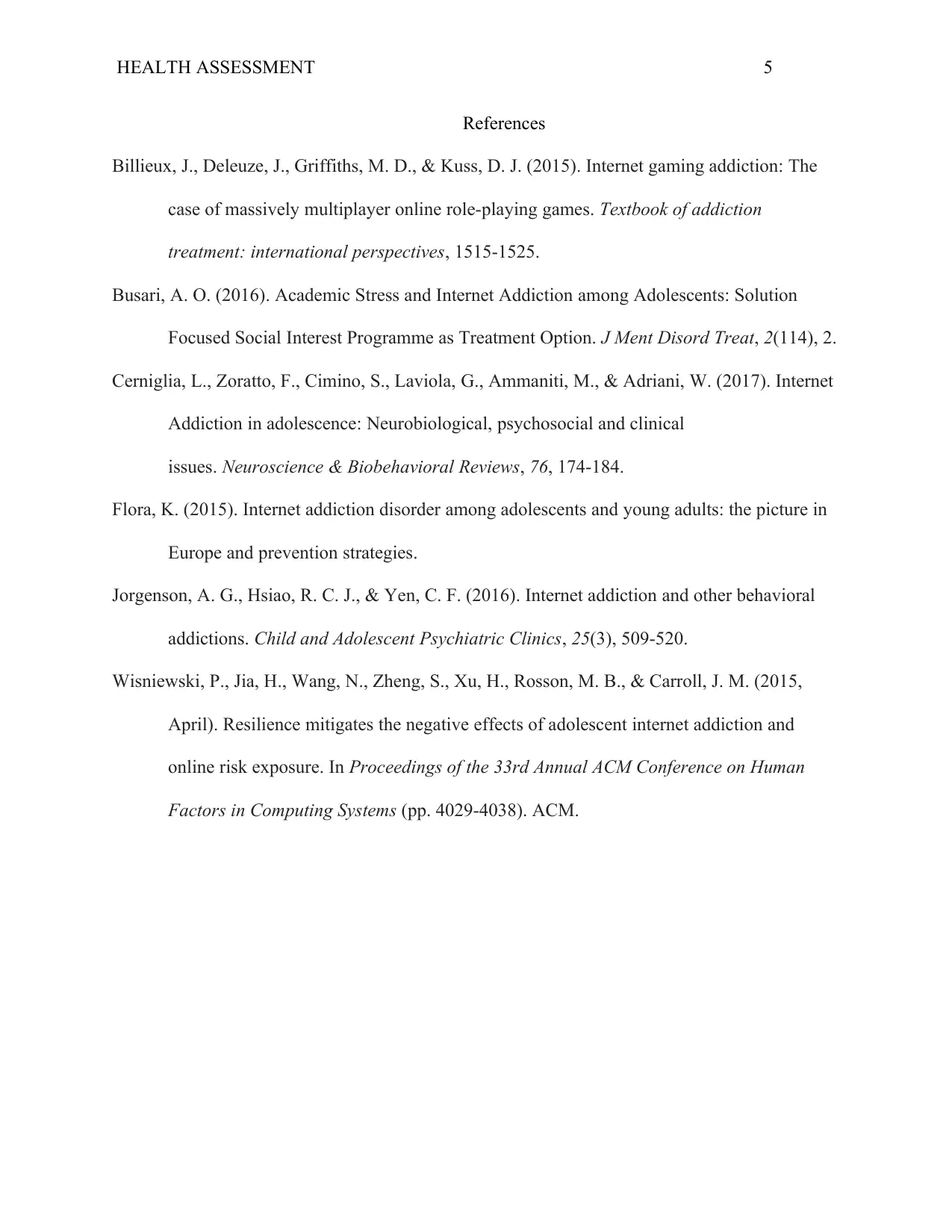
HEALTH ASSESSMENT 5
References
Billieux, J., Deleuze, J., Griffiths, M. D., & Kuss, D. J. (2015). Internet gaming addiction: The
case of massively multiplayer online role-playing games. Textbook of addiction
treatment: international perspectives, 1515-1525.
Busari, A. O. (2016). Academic Stress and Internet Addiction among Adolescents: Solution
Focused Social Interest Programme as Treatment Option. J Ment Disord Treat, 2(114), 2.
Cerniglia, L., Zoratto, F., Cimino, S., Laviola, G., Ammaniti, M., & Adriani, W. (2017). Internet
Addiction in adolescence: Neurobiological, psychosocial and clinical
issues. Neuroscience & Biobehavioral Reviews, 76, 174-184.
Flora, K. (2015). Internet addiction disorder among adolescents and young adults: the picture in
Europe and prevention strategies.
Jorgenson, A. G., Hsiao, R. C. J., & Yen, C. F. (2016). Internet addiction and other behavioral
addictions. Child and Adolescent Psychiatric Clinics, 25(3), 509-520.
Wisniewski, P., Jia, H., Wang, N., Zheng, S., Xu, H., Rosson, M. B., & Carroll, J. M. (2015,
April). Resilience mitigates the negative effects of adolescent internet addiction and
online risk exposure. In Proceedings of the 33rd Annual ACM Conference on Human
Factors in Computing Systems (pp. 4029-4038). ACM.
References
Billieux, J., Deleuze, J., Griffiths, M. D., & Kuss, D. J. (2015). Internet gaming addiction: The
case of massively multiplayer online role-playing games. Textbook of addiction
treatment: international perspectives, 1515-1525.
Busari, A. O. (2016). Academic Stress and Internet Addiction among Adolescents: Solution
Focused Social Interest Programme as Treatment Option. J Ment Disord Treat, 2(114), 2.
Cerniglia, L., Zoratto, F., Cimino, S., Laviola, G., Ammaniti, M., & Adriani, W. (2017). Internet
Addiction in adolescence: Neurobiological, psychosocial and clinical
issues. Neuroscience & Biobehavioral Reviews, 76, 174-184.
Flora, K. (2015). Internet addiction disorder among adolescents and young adults: the picture in
Europe and prevention strategies.
Jorgenson, A. G., Hsiao, R. C. J., & Yen, C. F. (2016). Internet addiction and other behavioral
addictions. Child and Adolescent Psychiatric Clinics, 25(3), 509-520.
Wisniewski, P., Jia, H., Wang, N., Zheng, S., Xu, H., Rosson, M. B., & Carroll, J. M. (2015,
April). Resilience mitigates the negative effects of adolescent internet addiction and
online risk exposure. In Proceedings of the 33rd Annual ACM Conference on Human
Factors in Computing Systems (pp. 4029-4038). ACM.
1 out of 5
Related Documents
Your All-in-One AI-Powered Toolkit for Academic Success.
+13062052269
info@desklib.com
Available 24*7 on WhatsApp / Email
![[object Object]](/_next/static/media/star-bottom.7253800d.svg)
Unlock your academic potential
Copyright © 2020–2025 A2Z Services. All Rights Reserved. Developed and managed by ZUCOL.





